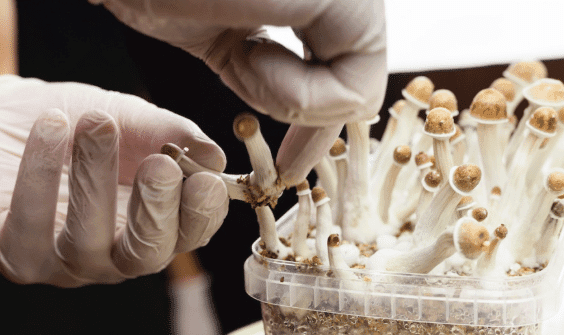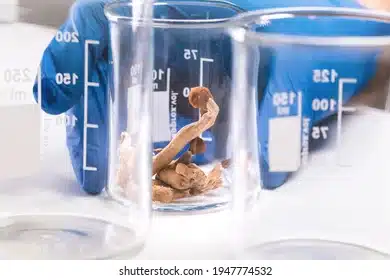Among psychedelic compounds, psilocybin is emerging from being a prohibited psychedelic compound found in particular mushroom species to become a promising compound for psychiatric and neurological benefits.
In this guide, we expand on the interest in psilocybin and explore its extraction, purification, and standardization. We examine the methods, equipment, and considerations involved in professional psilocybin extraction.
Sections
ToggleWhat Is Psilocybin and Why It's Being Researched

Psilocybin is a pro-drug tryptamine alkaloid found in some mushrooms. When consumed, the body converts it into psilocin, a compound that interacts with serotonin receptors to produce altered states of consciousness and perception. In several indigenous cultures psilocybin-containing mushrooms have been used ceremonially for thousands of years. However, modern medicine has only begun to seriously investigate its therapeutic potential in recent decades. Several current studies support psilocybin’s remarkable efficacy in treating treatment-resistant depression, anxiety, addiction disorders, and PTSD.
The Purpose of Psilocybin Extraction

Psilocybin extraction is done for several critical scientific and medical purposes. Extracted and purified psilocybin is essential for clinical trials as it eliminates variability between mushroom batches. It not only contains consistent alkaloid concentrations but also removes potentially problematic compounds, such as chitin.
Common Psilocybin Extraction Methods
Like cannabis, there are several psilocybin extraction methods:
1. Solvent-Based Extraction
The solvent-based psilocybin extraction method uses organic solvents, such as methanol, ethanol, or acidified water, to dissolve psilocybin from ground mushroom material. The process is simple, but it requires a careful choice of solvent to extract alkaloids based on their chemical properties and polarity, allowing for selective extraction.
2. Ultrasonic-Assisted Extraction (UAE)
The ultrasonic-assisted psilocybin extraction method uses high-frequency sound waves to create cavitation bubbles in the solvent. This disrupts the cell walls of mushrooms and accelerates the release of alkaloids. This is a revolutionary method that significantly reduces extraction time from hours to minutes while improving yield. These systems are increasingly adopted in research laboratories for their efficiency and ability to work at lower temperatures.
3. Supercritical CO2 Extraction
Supercritical CO2 uses carbon dioxide under controlled temperature and pressure for psilocybin extraction. Acting as both liquid and gas, supercritical CO2 can precisely and selectively extract compounds. This method produces the highest purity psilocybin extracts. Since there are no organic solvent residues, CO2-extracted psilocybin is ideal for pharmaceutical manufacturing and clinical-grade material.
Equipment Used in Psilocybin Extraction

A modern psilocybin extraction system is a sophisticated system with several components:
1. Extraction Units
For commercial psilocybin extraction, specialized vessels are used. They can range from simple glass extraction apparatus to sophisticated supercritical fluid systems. These units have precise temperature and pressure controls and are made from corrosion-resistant materials compatible with various solvents.
2. Filtration and Separation Systems
After initial extraction, the psilocybin solution is filtered through progressively finer membranes to remove particulates and fungal debris. More advanced systems use centrifugation to accelerate separation and vacuum filtration for faster processing.
3. Evaporation Systems
Commercial-grade extractors use rotary evaporators or vacuum distillation equipment to concentrate psilocybin in large volumes. These systems remove solvents under reduced pressure and controlled temperature, preventing thermal degradation of psilocybin while efficiently recovering solvents for reuse in subsequent extractions.
4. Crystallization and Drying Equipment
Purified psilocybin undergoes crystallization through precipitation and drying in vacuum ovens or freeze-dryers. Crystallization is essential for purification, as it enables psilocybin to form pure molecular structures, thereby leaving impurities in solution and producing a pharmaceutical-grade powder.
5. Laboratory Safety and Compliance Equipment
For safer and compliant psilocybin extraction, facilities must have fume hoods for safe solvent handling, chemical storage cabinets for flammable materials, personal protective equipment, including gloves and safety glasses, and proper ventilation systems.
Purity and Quality Control
1. Chromatography: With thin-layer chromatography (TLC), you can rapidly conduct a qualitative assessment of psilocybin purity in extracted samples.
2. HPLC or GC-MS Testing: High-performance liquid chromatography (HPLC) or gas chromatography-mass spectrometry (GC-MS) enables the precise evaluation of psilocybin concentration, comparable to pharmaceutical-grade standards.
3. Stability Testing: Accelerated aging studies and storage condition testing ensure extracted psilocybin maintains potency and purity throughout its intended shelf life.
Compliance and Safety
- Psilocybin extraction is only legal in licensed research facilities with appropriate DEA registrations.
- All personnel conducting psilocybin extraction must receive safety training for solvent handling, controlled substance protocols, and emergency response procedures.
- Detailed standard operating procedures, batch records, chain of custody documentation, and waste disposal protocols must be implemented.
Future of Psilocybin Extraction
There is a growing interest in psilocybin-assisted therapy. There is potential for FDA approval and broader legal access, and as extraction technology continues to evolve, we can expect greater efficiency, purity, and scalability. Innovations in biosynthesis may eventually supplement or replace traditional extraction, with genetically engineered organisms producing psilocybin directly.
Conclusion
Understanding the psilocybin extraction process is essential for producers exploring psychedelic extracts. With the advancement of medicine and technology, it is becoming easier to produce pharmaceutical-grade materials. As psilocybin extraction remains tightly regulated and limited to authorized research contexts, the compliance requirements must be thoroughly studied and implemented.

